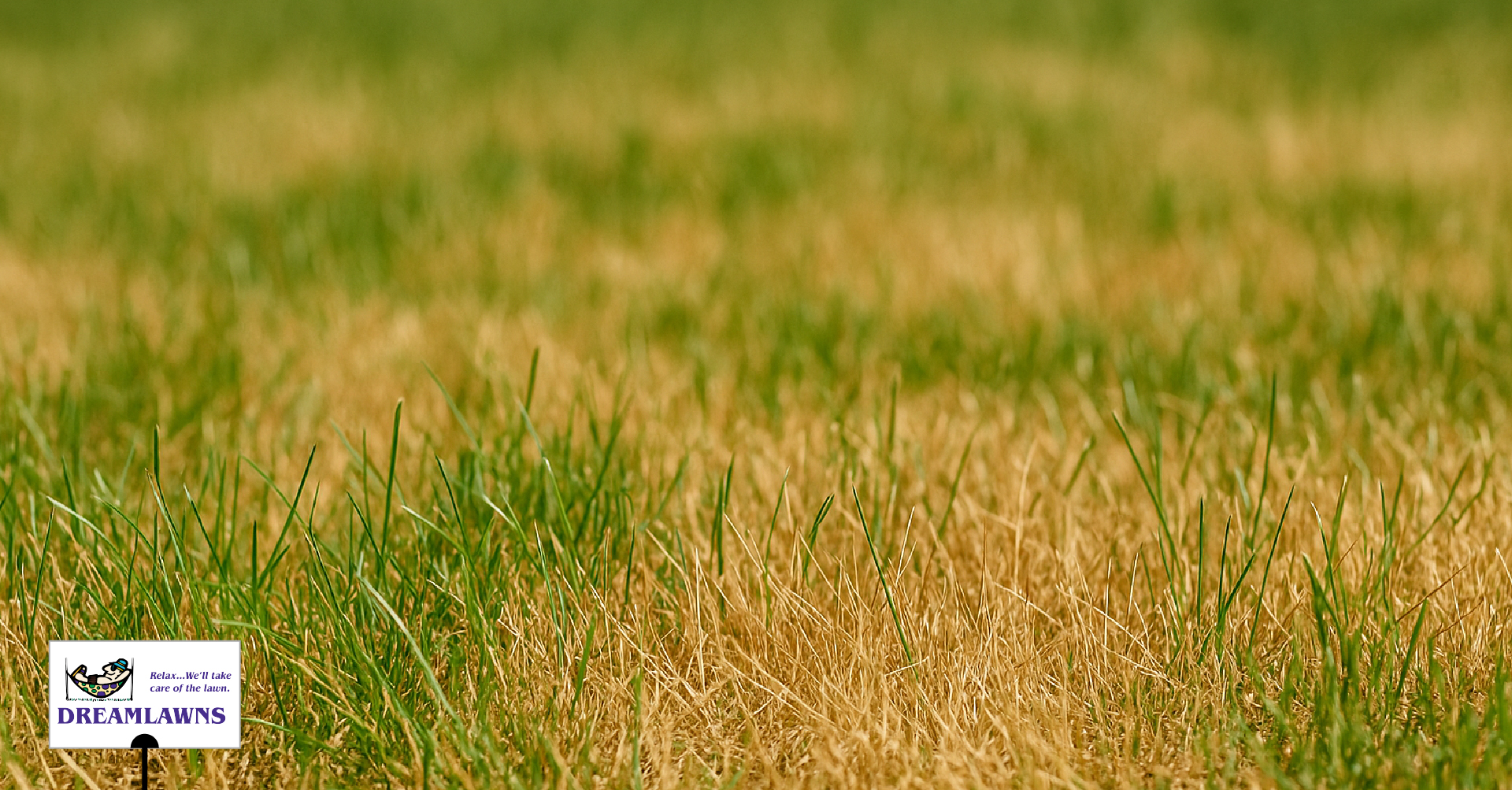
During the peak of summer in Virginia Beach, even the best-kept lawns can start to struggle. One day your grass looks fine, and the next it’s dull, limp, and dotted with brown patches. Homeowners naturally assume the solution is more water, but that’s not always the case. In fact, one of the biggest challenges in summer lawn care is correctly identifying what’s actually stressing your turf.
Heat stress and drought stress are two of the most common problems we see in Hampton Roads during July and August. They often show up at the same time, and their symptoms can look almost identical. But here’s the catch: they’re not the same thing, and treating them the same way can actually make things worse.
Misdiagnosing summer stress can lead to overwatering, disease outbreaks, or even long-term turf damage. That’s why understanding the difference between heat stress and drought stress is critical. By knowing what to look for and how to respond, you can protect your lawn through even the hottest months of the year.
What Is Drought Stress?
Drought stress is exactly what it sounds like: your lawn isn’t getting enough water. During hot, dry spells in Virginia Beach, evaporation outpaces moisture in the soil. When that happens, grass begins to conserve resources by going into a survival mode. It may look sick, but in reality, it’s trying to protect itself.
Signs of Drought Stress:
Footprinting: Walk across your lawn, and the grass stays flat where your feet were. This is one of the earliest and most obvious signs.
Curled or needle-like blades: Grass rolls its blades inward to reduce surface area and minimize water loss.
Dull, blue-gray coloration: Instead of the usual vibrant green, the turf takes on a muted, almost dusty appearance.
These symptoms usually appear in full-sun areas first, especially if the soil is sandy or compacted. Lawns that haven’t been watered consistently, or that rely entirely on rainfall, are particularly vulnerable.
The Fix: Deep, Infrequent Watering
Drought stress is one of the most treatable forms of lawn stress, as long as it’s addressed early. The solution isn’t daily sprinkling, but deep, infrequent irrigation, typically 1 to 1.5 inches of water per week, delivered in one or two sessions. This kind of watering reaches the root zone, helping the grass recover while encouraging deeper root growth, which boosts long-term drought resistance. Just as important: watering early in the day, ideally between 5 a.m. and 9 a.m. This reduces evaporation loss and prevents fungal diseases that thrive in warm, wet conditions.
What Is Heat Stress?
Unlike drought stress, which stems from a lack of water, heat stress is driven by high temperatures, especially in the soil. In Virginia Beach, where humidity and intense summer heat often combine, even well-watered lawns can show signs of distress when soil temps soar into the 80s or higher.
Grass is a cool-season or warm-season plant, depending on its variety, but all turf types have a threshold where heat becomes a limiting factor. Once temperatures climb past that point, the grass starts to struggle with photosynthesis, moisture retention, and energy production.
Signs of Heat Stress:
Slowed growth: Mowing frequency may decrease as the grass begins conserving energy.
Patchy thinning: Areas of the lawn, especially those in full sun or with poor airflow, start to open up.
Discoloration: Turf may appear washed out or develop a blue or purplish sheen, especially in midday heat.
Grass “fatigue”: The lawn may look tired, flat, or lifeless even with regular watering.
Heat stress is especially common in compacted soils, poorly drained areas, or turf that is mowed too short. Fescue lawns, in particular, are vulnerable to summer heat in the Tidewater area, often showing signs of decline as early as June.
The Challenge:
The key frustration with heat stress is that more water won’t necessarily help. In fact, it may backfire by creating soggy conditions that attract fungal disease. That’s why proper diagnosis and restraint are so important. Instead of watering more, the best strategy for heat stress is to minimize additional pressure on the lawn. That means mowing high, reducing foot traffic, and protecting the turf from disease and insect threats until temperatures ease.
Shared Symptoms: What to Look For
One of the main reasons homeowners confuse drought stress and heat stress is that they often look exactly the same on the surface. Both conditions cause the lawn to lose its lush appearance, and both can show up suddenly during the first wave of summer heat.
Here are the most common symptoms that overlap between the two:
Footprinting or Visible Mower Lines
If you walk across your lawn and your footprints remain visible, or if your mower leaves lasting tracks, it’s a sure sign that the grass blades are low on moisture. However, this can happen with both drought and heat stress, making it a general indicator that your lawn is under pressure.
Curling or Needle-like Grass Blades
In both cases, grass blades will roll inward to reduce their surface area and limit moisture loss. The appearance is subtle but important: if the lawn looks “spiky” or unusually thin, stress is likely setting in.
Color Changes: Blue, Purple, or Gray Hues
Grass under stress often loses its vibrant green color and takes on a bluish or purplish cast, especially during the heat of the day. These color shifts signal that the turf is struggling with either moisture retention (drought) or heat management (heat stress).
Patchiness, Thinning, or Lawn Fatigue
Whether from heat or lack of water, stressed turf starts to look tired. You may see bare spots developing, especially in sunny or high-traffic areas. The lawn might appear “flat” or have an overall lackluster appearance.
While these symptoms don’t definitively tell you whether your lawn is suffering from drought or heat, they do point to a larger issue: your lawn is under stress and needs attention. The next step is responding appropriately and not making things worse with well-intentioned mistakes.
How to Respond: Best Practices for Both Conditions
Whether your lawn is suffering from drought stress, heat stress, or a combination of both, the fundamentals of care remain the same. These strategies won’t just help your lawn recover, they’ll also build long-term resilience so you’re better prepared for next year’s heat.
Mow High
One of the simplest and most effective ways to protect your lawn is to raise your mower height. Keeping turf longer:
- Shields the soil from direct sunlight
- Encourages deeper root systems
- Retains moisture more effectively
- Reduces the chance of scalping stressed grass
For Tall Fescue in particular, this means mowing at 3.5″ to 4″ during the summer months. Bermuda and Zoysia grasses prefer shorter heights, but still benefit from avoiding excessive cutbacks.
Mulch Your Clippings
Instead of bagging your clippings, let them return to the lawn. Mulched grass blades act as a natural barrier, helping to hold in soil moisture and shade the ground. Plus, they return valuable nutrients to the soil.
Water Deeply and Infrequently
Regardless of whether you’re dealing with heat or drought, your watering strategy should be the same:
- 1″ to 1.5″ per week, delivered in one or two deep sessions
- Water early in the morning, ideally before 9 a.m.
- Avoid shallow, frequent watering, which encourages weak roots and promotes disease
This approach trains grass roots to grow deep, making them more resilient during dry periods.
Avoid Over-Fertilizing in Summer
Adding fertilizer when turf is already stressed can do more harm than good. High nitrogen applications in extreme heat can lead to burning, disease outbreaks, and wasted resources. Instead, stick to your program’s summer blend, or let Dreamlawns adjust your treatments based on weather and soil needs.
Know Your Turf Type
Each grass variety responds differently to stress:
- Tall Fescue doesn’t spread and is more vulnerable to summer thinning
- Bermuda and Zoysia grasses tolerate heat better, but still require proper care
- St. Augustine prefers consistent moisture but is susceptible to fungal disease in wet, humid conditions
Knowing your turf type will allow you to better understand the summer stress strategies that apply to your lawn.
What Happens If You Do Nothing?
Lawn stress doesn’t resolve on its own. Ignoring the early signs of drought or heat damage can quickly turn minor turf fatigue into major long-term issues, some of which may require expensive or time-consuming fixes.
Here’s what can happen if summer stress goes unaddressed:
Dormancy or Dieback
While some turf types naturally go dormant in summer, Fescue does not. That means what looks like dormancy is often actual dieback. Once patches thin or die off completely, reseeding in the fall may be necessary to restore the lawn’s appearance and health.
Increased Weed Pressure
Thinning turf creates open real estate for opportunistic weeds, especially aggressive summer invaders like crabgrass, spurge, and nutsedge. These weeds not only outcompete weakened grass, but they’re also harder to control once established.
Fungal Diseases
Stressed lawns are more susceptible to disease, especially when homeowners respond to browning with excess water. Common summer fungi like brown patch and gray leaf spot thrive in moist, warm conditions, compounding the stress your turf is already under.
Insect Infestations
Turf that’s weakened by heat or drought stress is less able to withstand damage from lawn-damaging insects like fall armyworms, grubs, and chinch bugs. When grass is already struggling, even minor insect activity can lead to a significant decline.
How Dreamlawns Helps You Prepare, Recover, and Stay Resilient
At Dreamlawns, we understand that managing lawn stress in Virginia Beach isn’t a one-size-fits-all task. The summer climate here can be unpredictable, long dry spells, sudden storms, and extreme humidity, and your turf needs a plan that adapts with the weather.
That’s why we take a property-specific approach to every lawn. Whether you’re dealing with drought stress, heat stress, or a combination of both, we’re here to help you identify the symptoms, implement the right strategies, and set realistic expectations for recovery.
Tailored Plans for Your Turf Type
We consider your grass variety, soil type, recent weather trends, and upcoming seasonal challenges to build a plan that actually works. This includes:
- Adjusted fertilization schedules to avoid overfeeding during heat waves
- Strategic fungicide and insecticide treatments to stop problems before they spread
- Thoughtful watering and mowing recommendations based on what your lawn actually needs
Education and Transparency
We don’t believe in guesswork or cookie-cutter care. If we suspect stress in your lawn, we’ll help you determine what’s causing it before recommending any changes. Our goal is to keep you informed and empowered to make smart choices for your property.
Realistic Expectations and Season-Long Support
Summer stress happens, even to well-maintained lawns. The difference is how you respond and who you partner with. We’ll help you minimize damage, recover faster, and set your lawn up for a strong fall comeback.
Stress Happens, But It Doesn’t Have to Win
Heat and drought are part of summer life in Virginia Beach. But a brown lawn doesn’t have to be the norm. With the right mowing, watering, and seasonal care, and a lawn partner who knows the climate inside and out, you can help your lawn not only survive the summer but come back even stronger.
Want a plan tailored to your lawn? Let Dreamlawns help you navigate the heat with confidence. Contact us today to schedule a property assessment and get expert advice specific to your property.
Dreamlawns provides superior lawn care service to Virginia Beach & Chesapeake VA residents.




